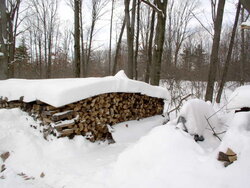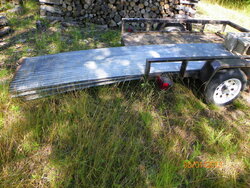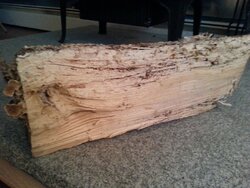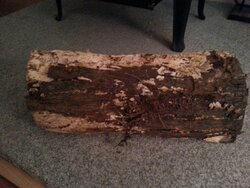I'm burning some wood that has been seasoning for many years. It's very dry. Some of it is soft on the outside, bit pithy. The issue is that it doesn't like to burn unless I has the air wide open. I can't wait to be done with it. Has anyone else ever have this issue?
Poor wood quality
- Thread starter tsquini
- Start date
-
Active since 1995, Hearth.com is THE place on the internet for free information and advice about wood stoves, pellet stoves and other energy saving equipment.
We strive to provide opinions, articles, discussions and history related to Hearth Products and in a more general sense, energy issues.
We promote the EFFICIENT, RESPONSIBLE, CLEAN and SAFE use of all fuels, whether renewable or fossil.
You are using an out of date browser. It may not display this or other websites correctly.
You should upgrade or use an alternative browser.
You should upgrade or use an alternative browser.
- Status
- Not open for further replies.
DanCorcoran
Minister of Fire
How many years since the wood was split and stacked? Was it covered on top, all around, or not at all?
red oak
Minister of Fire
4 years and has not been covered.
sounds like the wood is a bit punky, which combined with not being covered, will absorb moisture. I think if you were to cover it for a time you would have much better results.
bluedogz
Minister of Fire
I've had the same problem here and there... perhaps dig through your pile and find good pieces to burn, then mix in a punky one or two with each load. It's unlikely your whole stack has gone punky all at once.
O
oldspark
Guest
mass_burner
Minister of Fire
jdp1152
Minister of Fire
Take an x7 to the punky parts and bring your wood in to get some dry heat. I got a late jump on moving wood this year because my usual spot (covered porch) was removed so I planned on using the garage....which was filled with construction debris up until last week. Big cold snap moving through so I moved a good supply in but after two weeks of off and on rain/snow they're all pretty damp. None of it is punky and inside a fresh split is 17%, but the logs still burn like crap at onset cooking off the recent moistures. Stacking the next load in front of the insert for 5-6 hrs has helped tremendously. Hopefully they will dry out in the garage and I can go back to bringing one load at a time. The wife is complaining about the mess that is usually confined to the tuffduck. I'm leaning towards becoming a top cover convert to avoid situations like this.
O
oldspark
Guest
Top covering in the fall with wood that you will burn that winter is a must.
I have to top cover. This is the first year I experiencing this. I'm surprised how hard it is to keep punky wood burning. Luckily, I have other wood to use, but I want to get through this stuff. I have about 1/8 cord left. I don't have the heart to only using them in the for firepit.
gyrfalcon
Minister of Fire
What kind of wood, just curiously? And where and how did you have it stacked?I have to top cover. This is the first year I experiencing this. I'm surprised how hard it is to keep punky wood burning. Luckily, I have other wood to use, but I want to get through this stuff. I have about 1/8 cord left. I don't have the heart to only using them in the for firepit.
It is mostly maple, birch and ash. I have a small yard with mostly shade from trees on my neighbors yard. The only place to stack is under the tree shade. It gets a good amount of air flow by not much sun. I do not cover my stacks. That is the biggest issue. I have to overcome my dislike using tarps.
I have 3 rows of stacks on pallets 24' long 5' tall about 1' space I between each stack. I'm about 3 years ahead with wood supply. With my methods of storage and space available softer wood can not hold up.
I have 3 rows of stacks on pallets 24' long 5' tall about 1' space I between each stack. I'm about 3 years ahead with wood supply. With my methods of storage and space available softer wood can not hold up.
Attachments
Last edited:
gyrfalcon
Minister of Fire
Well, there you go. Stacking that close and in the shade is a recipe for problems, but if you're stuck with that, you're stuck.It is mostly maple, birch and ash. I have a small yard with mostly shade from trees on my neighbors yard. The only place to stack is under the tree shade. It gets a good amount of air flow by not much sun. I do not cover my stacks. That is the biggest issue. I have to overcome my dislike using tarps.
I have 3 rows of stacks on pallets 24' long 5' tall about 1' space I between each stack. I'm about 3 years ahead with wood supply. With my methods of storage and space available softer wood can not hold up.
Seems to me that covering this kind of stack is only going to trap the moisture the drying wood is outgassing, but give it a try. I have to buy my wood, and when I was buying green, I never covered until the wood was ready to burn. I could stack it in single rows in full sun and wind, though, which creates very different conditions.
Birch (what kind of birch? It ranges from very dense high-btu black birch to lightweight white birch, with yellow birch in between), btw, is particularly susceptible to fast deterioration -- because of that pretty bark which holds moisture in-- so it might make sense for you to separate it from the ash and use it sooner. Beech is another one that for some reason seems to just suck up water and go bad very quickly. Maple will go, too, but a bit more slowly. It's also fairly quick to dry. (What kind of maple? I don't have much experience with soft maple, only nice hard rock or sugar maple.)
Since you have far less than ideal seasoning conditions, I think paying some attention to the different species, how quickly they season and how quickly they rot, might be worth some thought.
I HATE fighting with tarps and only use them in winter to cover otherwise dry ready-to-burn wood because I don't want to fuss with drying the fuel out after a snowstorm. You might look into finding hard rubber or metal roof panels instead, as some people do here.
Your right on. Last year I started making 2 different stacks. One for softer woods maple, white birch, ash. The other stack is oak and locust. The hope is that I can use the softer wood quicker while saving hard wood for longer seasoning.
I had have 4 cords. It breaks up about 1/3 hard wood 2/3 soft.
I had have 4 cords. It breaks up about 1/3 hard wood 2/3 soft.
gyrfalcon
Minister of Fire
That should help. I struggled to heat my home with a tiny Hearthstone Tribute for 5 years before I finally gave in and raided the retirement $$ to get the bigger Heritage, and the experience taught me a lot about the differences in both drying and burning characteristics of different kinds of wood just as a matter of winter survival.Your right on. Last year I started making 2 different stacks. One for softer woods maple, white birch, ash. The other stack is oak and locust. The hope is that I can use the softer wood quicker while saving hard wood for longer seasoning.
I had have 4 cords. It breaks up about 1/3 hard wood 2/3 soft.
Oak (red or white?) is going to take years to dry in your conditions, so you're wise to separate it from the comparatively quick-drying ash and maple. Do watch out for the condition of the white birch particularly. It seasons really fast, but it also soaks up wet and rots really fast.
Given your circumstances, it also might be worthwhile stacking with bark up, at least for the top couple of rows. Whether you cover your stacks or not, the bark is there to protect the wood, so it makes sense to me to make use of that.
Paulywalnut
Minister of Fire
Like jdp said trim off the punky stuff. I've done that with some walnut and oak. The heart wood is still real good. It will then dry
almost over night near the woodstove.
almost over night near the woodstove.
mass_burner
Minister of Fire
Probably over-thinking this one. The tree is down, what could the neighbors possibly objection. Take some pics, process the tree. I bet you they won't eve
I've gotten this type of wood on scrounges. Sometimes I think its more trouble than its worth.
When I was a kid we would find wood like that when Dad was cutting stuff up. I d ask him you want this stuff. He would say throw it on we'll get some heat out of it.
I've gotten this type of wood on scrounges. Sometimes I think its more trouble than its worth.
Backwoods Savage
Minister of Fire
It is mostly maple, birch and ash. I have a small yard with mostly shade from trees on my neighbors yard. The only place to stack is under the tree shade. It gets a good amount of air flow by not much sun. I do not cover my stacks. That is the biggest issue. I have to overcome my dislike using tarps.
I have 3 rows of stacks on pallets 24' long 5' tall about 1' space I between each stack. I'm about 3 years ahead with wood supply. With my methods of storage and space available softer wood can not hold up.
Contrary to popular opinion, wood will dry just fine in the shade so long as it is stacked properly and top covered.
I too dislike tarps. That is why we use this:


Old galvanized roofing.
I do not understand why you state that softer wood can not hold up. Could you please explain?
With my conditions and method of stacking in the shade, off the ground on pallets, without top cover. The wood does season. But the outside of the wood goes through wet and dry cycle over and over eventually breaking down the wood fiber after a few years. When burning, the punky part of the wood smolders more than it burns. It's more maintenance to keep the fire going that way. I have about 1/8 of a cord now I'm burning that is this way. It has been stacked for 4 years and the outer most part of the wood has gotten punky.I do not understand why you state that softer wood can not hold up. Could you please explain?
Last year I started making different stacks based on the different dry time of wood. This way I can better maintain my fuel quality. I can try the corrugated roofing. With that I can overhang the edge of the wood by a few inches.
O
oldspark
Guest
If your wood is getting punky it is not drying out quickly enough after rainfall, the wood needs to dry out the surface moisture quickly to avoid this, in the shade is OK if it gets good air flow over it, it will dry out quicker if the sun is hitting the stacks but you can get by with out it. Top covering in this case would be better, my wood does not get punky after a few years (single rows no top cover) and some of it is in a some what shady area but the wind blows a lot here.With my conditions and method of stacking in the shade, off the ground on pallets, without top cover. The wood does season. But the outside of the wood goes through wet and dry cycle over and over eventually breaking down the wood fiber after a few years. When burning, the punky part of the wood smolders more than it burns. It's more maintenance to keep the fire going that way. I have about 1/8 of a cord now I'm burning that is this way. It has been stacked for 4 years and the outer most part of the wood has gotten punky.
Last year I started making different stacks based on the different dry time of wood. This way I can better maintain my fuel quality. I can try the corrugated roofing. With that I can overhang the edge of the wood by a few inches.
Jotul118
Member
You know, it's interesting because I took down a standing dead maple a short time ago and thought I was off to the races with ready to burn wood. Think again! I did a head scratch or two (or maybe three) before I did a Google query. I guess it just sort of absorbs the moisture, even more so without the bark.
I'm letting most of it sit stacked in a single row with a top cover. It's my first season burning with this stove and I just keep looking for stuff I can burn without having to give it a year or more to season.
I did find some nice larger red oak branches that have been sitting around a good couple years and once they where able to air out in the sun for a stretch a short time ago, they are sitting poised by the stove and burning great.
I'm letting most of it sit stacked in a single row with a top cover. It's my first season burning with this stove and I just keep looking for stuff I can burn without having to give it a year or more to season.
I did find some nice larger red oak branches that have been sitting around a good couple years and once they where able to air out in the sun for a stretch a short time ago, they are sitting poised by the stove and burning great.
jatoxico
Minister of Fire
You know, it's interesting because I took down a standing dead maple a short time ago and thought I was off to the races with ready to burn wood. Think again! I did a head scratch or two (or maybe three) before I did a Google query. I guess it just sort of absorbs the moisture, even more so without the bark.
I'm letting most of it sit stacked in a single row with a top cover. It's my first season burning with this stove and I just keep looking for stuff I can burn without having to give it a year or more to season.
I did find some nice larger red oak branches that have been sitting around a good couple years and once they where able to air out in the sun for a stretch a short time ago, they are sitting poised by the stove and burning great.
Before the wood is CSS (
 ) the drying process just does not get very far. So I don't think its so much reabsorption as it is never dried in the the first place. I know I've split a ton of dead standing and its almost as wet as green, no quite but almost. That's why you will hear over and over on Hearth to get it bucked and split. The guys here are right about that one.
) the drying process just does not get very far. So I don't think its so much reabsorption as it is never dried in the the first place. I know I've split a ton of dead standing and its almost as wet as green, no quite but almost. That's why you will hear over and over on Hearth to get it bucked and split. The guys here are right about that one.Jotul118
Member
Very interesting! In that case, does it need to sit roughly a full season before burning like fresh cut? With winter here it's just not going to get a leg up in that department correct?Before the wood is CSS () the drying process just does not get very far. So I don't think its so much reabsorption as it is never dried in the the first place. I know I've split a ton of dead standing and its almost as wet as green, no quite but almost. That's why you will hear over and over on Hearth to get it bucked and split. The guys here are right about that one.
- Status
- Not open for further replies.
Similar threads
- Replies
- 3
- Views
- 271



